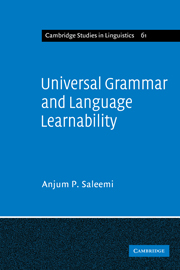Book contents
- Frontmatter
- Contents
- Preface
- 1 The problem of language learnability
- 2 The components of the linguistic system
- 3 The components of the learning system
- 4 Approaches to parameter fixation
- 5 The scope and limits of the current approaches
- 6 The distribution and variety of null subjects
- 7 Augmented parameter fixation: pro subjects and learnability
- 8 Review and integration
- Notes
- References
- Index
4 - Approaches to parameter fixation
Published online by Cambridge University Press: 04 August 2010
- Frontmatter
- Contents
- Preface
- 1 The problem of language learnability
- 2 The components of the linguistic system
- 3 The components of the learning system
- 4 Approaches to parameter fixation
- 5 The scope and limits of the current approaches
- 6 The distribution and variety of null subjects
- 7 Augmented parameter fixation: pro subjects and learnability
- 8 Review and integration
- Notes
- References
- Index
Summary
This chapter begins to explore some central learnability and acquisitional issues with reference to the parameter-setting model of language learnability. Two broad approaches, namely the formal approach and the developmental approach, are considered. First a formal overview of the model is presented; this is followed by the description of a specific formal proposal, namely the set-theoretical approach to parameter fixation presented in Wexler and Manzini (1987) and Manzini and Wexler (1987). Then a developmental interpretation of the model, largely based on Hyams (1986), is described at some length.
The formal approach
Let us start with a general outline of the essential background to this approach, briefly recapitulating some material from the previous chapter. The Aspects model (Chomsky 1965) viewed linguistic competence as a product of the ability of a hypothetical language acquisition device (or LAD) to construct transformational grammars after having operated on a set of primary linguistic data. Linguistic theory so conceived provided an enumeration of possible grammars G1, G2, …, Gn, and an evaluation measure that would assign values to the potential grammars. Acquisition (in an abstract and idealized sense) occurred as a result of the selection of the most highly valued grammar which was compatible with the data. The LAD was construed as a system of formulation and evaluation of hypotheses, the latter being grammars each of which had to be selected or rejected in toto.
- Type
- Chapter
- Information
- Universal Grammar and Language Learnability , pp. 57 - 75Publisher: Cambridge University PressPrint publication year: 1992



